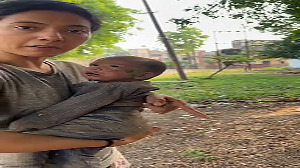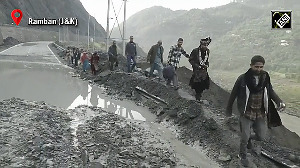There is much more to the September 24 Ayodhya verdict than just the settlement of 'who owns the disputed land' issue.
The much-awaited judgment on Friday to decide the title suit on ownership of the land on which the Babri Mosque stood in Ayodhya until its demolition on December 6, 1992 involves 28 issues framed by the special Lucknow bench of the Allahabad high court.
The court may not rule on each of these issues, but it seems to have left no avenue unexplored, even directing excavation of the site to unearth evidence.
There are actually five title suits before the court that it has to decide on even though its ruling will also dispose of dozens of other petitions for access, right to worship or pray, write petitions and the like.
It is to be seen whether the court can settle issues that are historical or mythological, as back in 1994, the Supreme Court had refused to go into these very aspects while returning a Presidential reference on the matter.
The first suit goes back to 1885 when Mahant Raghubar Das filed a title suit in a Faizabad court to build a chabutra (raised platform) on the outer courtyard of the disputes structure, but his suit was dismissed on the ground that the event (alleged demolition of an original Ram temple in 1528) had occurred over 350 years earlier, and so it was 'too late now' to remedy the grievance.
It was revived in December 1949 when some people broke open the structure's locks and installed a Ram idol and articles of worship and the administration ordered the status quo that led to two separate civil suits filed on January 16, 1950 by Hindu Mahasabha member late Gopal Singh Visharad and Paramhansa Ramchandra Das, keeper of the Digambar Akhada in Ayodhya.
Friday's judgment will not be a final verdict on the dispute that has been raging for decades as to whether there was the Ram mandir at the site that was pulled down to build the mosque, as it can be appealed in the Supreme Court by either side.
Even the Supreme Court ruling can be challenged for a review by the same bench or by a 5-judge bench through a curative petition.
All the same, the issues that the judges framed for ruling try to cover every possible aspect under the legal system.
These include:
- Whether the demolished structure was a mosque as claimed by the plaintiff Muslim organisations;
- If so, when was it built and by whom -- Mughal emperor Babar or his Awadh governor Mir Baqi Tashqandi;
- Was it built on the site of a demolished Hindu temple?
- Whether Muslims prayed in the Babri mosque from time immemorial;
- Whether they possessed the property openly and continuously from 1528 when it was allegedly built;
- Whether they possessed it till 1949 when they were dispossessed;
- Whether the suit was filed too late;
- Whether the Hindus have earned the right to pray at the site through adverse and continuous possession;
- Whether the plot is Ram's birthplace;
- Whether Hindus have worshipped the site as Ram's birthplace from time immemorial;
- Whether the idols and other objects of worship were placed in the structure on the night of December 22-23, 1949, or whether they had been there before.
Other issues framed in the course of handling the suit that may be decided are:
- Whether the Ram chabutra -- the raised platform adjacent to the disputed structure -- as well as the Bhandar and Sita Rasoi were demolished along with the main structure;
- Whether the land adjoining the structure on its east, north and south housed an ancient graveyard and a mosque;
- Whether the structure is 'landlocked' and cannot be reached except by passing through Hindus' places of worship around it;
- Whether no mosque can come into existence on the plot in view of Islamic tenets (because idols have been placed there);
- Whether the structure could not legally be a mosque since it did not have minarets;
- Whether it could not be a mosque as it is hemmed in by a graveyard from three sides;
- Whether, after the demolition, it can still be called a mosque;
- Whether Muslims can use the open ground at the site as a mosque to offer prayers following the demolition of the structure;
- Whether and what relief, if any, the plaintiffs (Muslim organisations) are entitled to.
Pending settlement of the land title dispute, the Centre became the statutory receiver of all the disputed 67.7 acres of land since January 7, 1993, through the Acquisition of Certain Area at Ayodhya Act.
The Centre will, therefore, be ordered by the high court to implement its verdict in transferring land to the right owners, though it may hold back the immediate implementation, citing the law and order problem.
The Centre, however, cannot challenge the verdict before the Supreme Court since it is not a party to the case. It, however, has powers to enact a law to undo the court order as it had done in the Shah Bano case of 1986 to invalidate a Supreme Court judgment.
Legal experts, however, see a difference between the Shah Bano and Ayodhya cases. They argue the apex court's 1986 ruling on the maintenance due to divorced Muslim women was based on an interpretation of the Muslim personal law.
The Ayodhya ruling is expected to be based on the court's findings and not on interpretation.
The Uttar Pradesh government is one of the defendants, and as such it can certainly challenge the verdict and seek a status quo. The Centre will have to attach itself to any such petition the UP government moves before the Supreme Court.
The Hindu Mahsabha's late Visharad and Paramhansa Ramchandra Das, who were the first two people to file the title suits in 1950, are now represented in the case by the former's son Rajenda Singh Visharad, a retired bank officer, and Mahant Ram Das, Paramhansa Ramchandra Das's disciple.
Others party to the dispute are the Nirmohi Akhara, who filed the third suit in December 1959 wanting to take control of the property, and the Sunni Central Wakf Board, which sought in 1961 to hand over the plot to it, seeking declaration of the structure as a mosque and removal of idols and other articles.
All four suits were combined in 1964. A new dimension was added in July 1989 when retired Allahabad high court judge Deoki Nandan Agrawal filed yet another suit on behalf of the 'Ram Lalla' (young Ram) installed; his representatives are now party to the case.
The Vishwa Hindu Parishad, the Ramjanambhoomi Nyas and the Babri Masjid Action Committee, who have been agitating over the Ram temple versus Babri Masjid dispute, were never direct parties in the case though the BMAC became a litigant by proxy.
ALSO READ: How to defuse the Ayodhya crisis






 © 2025
© 2025